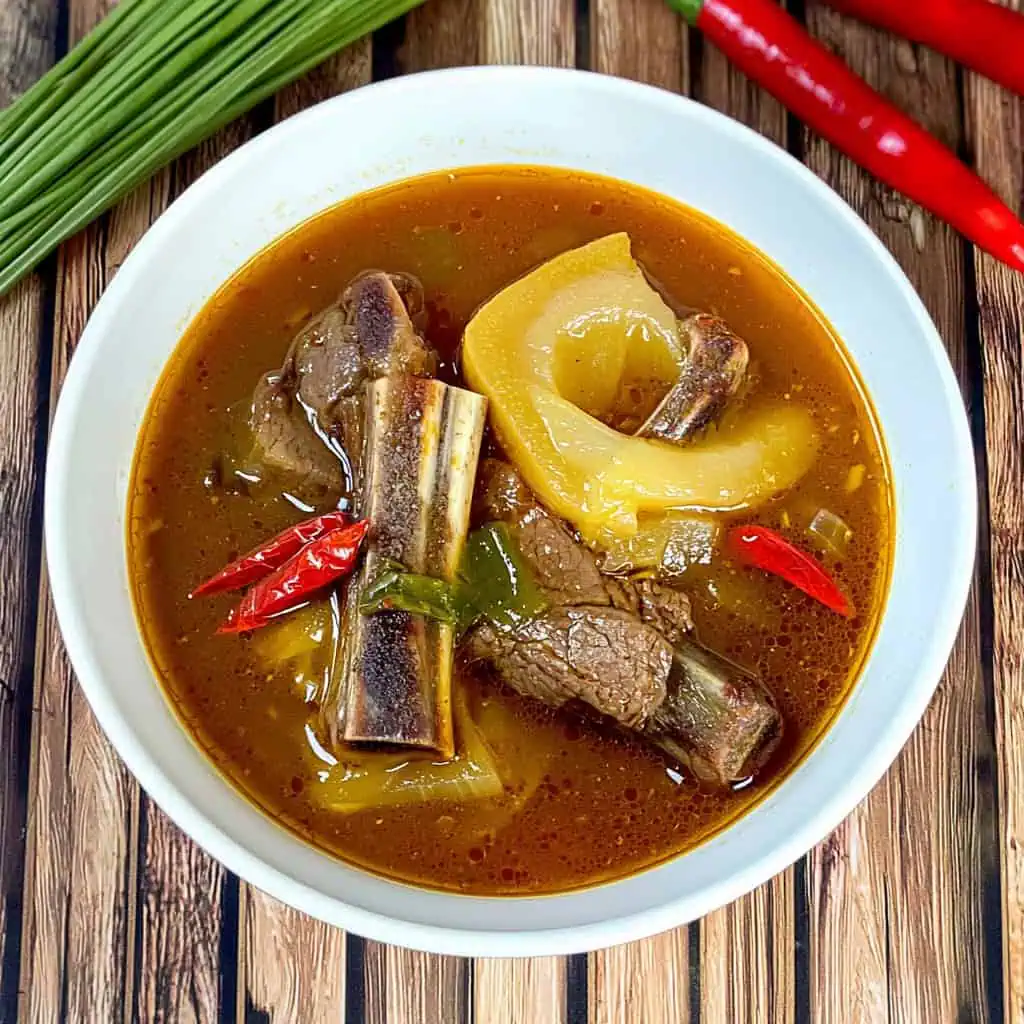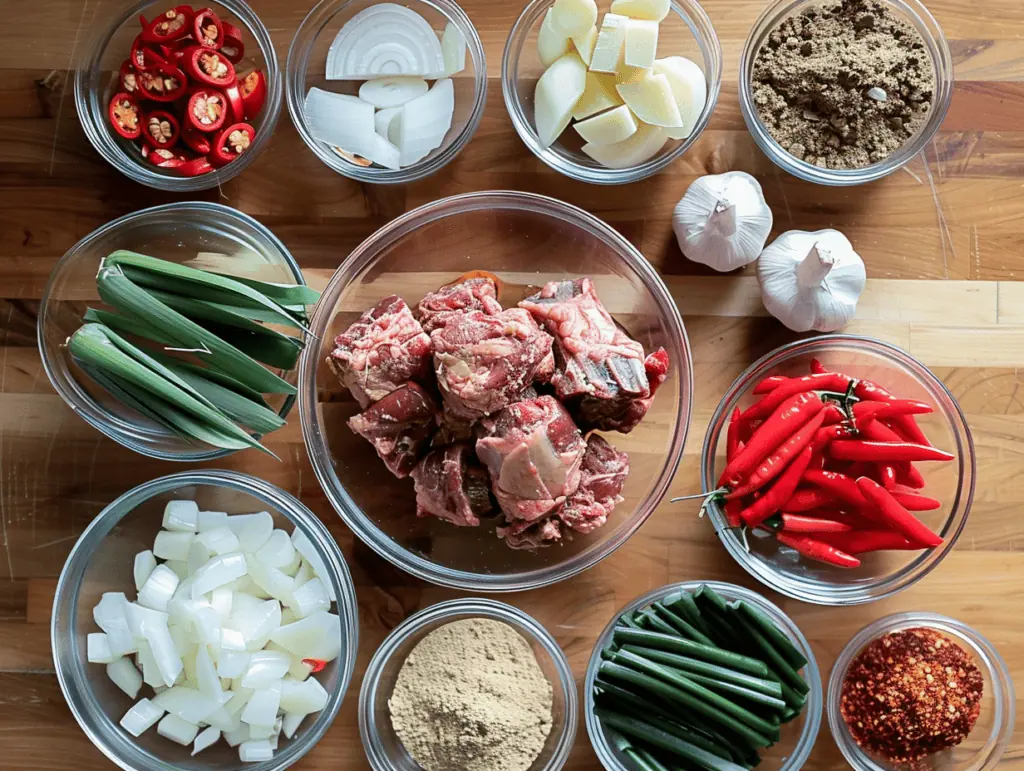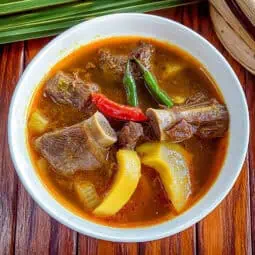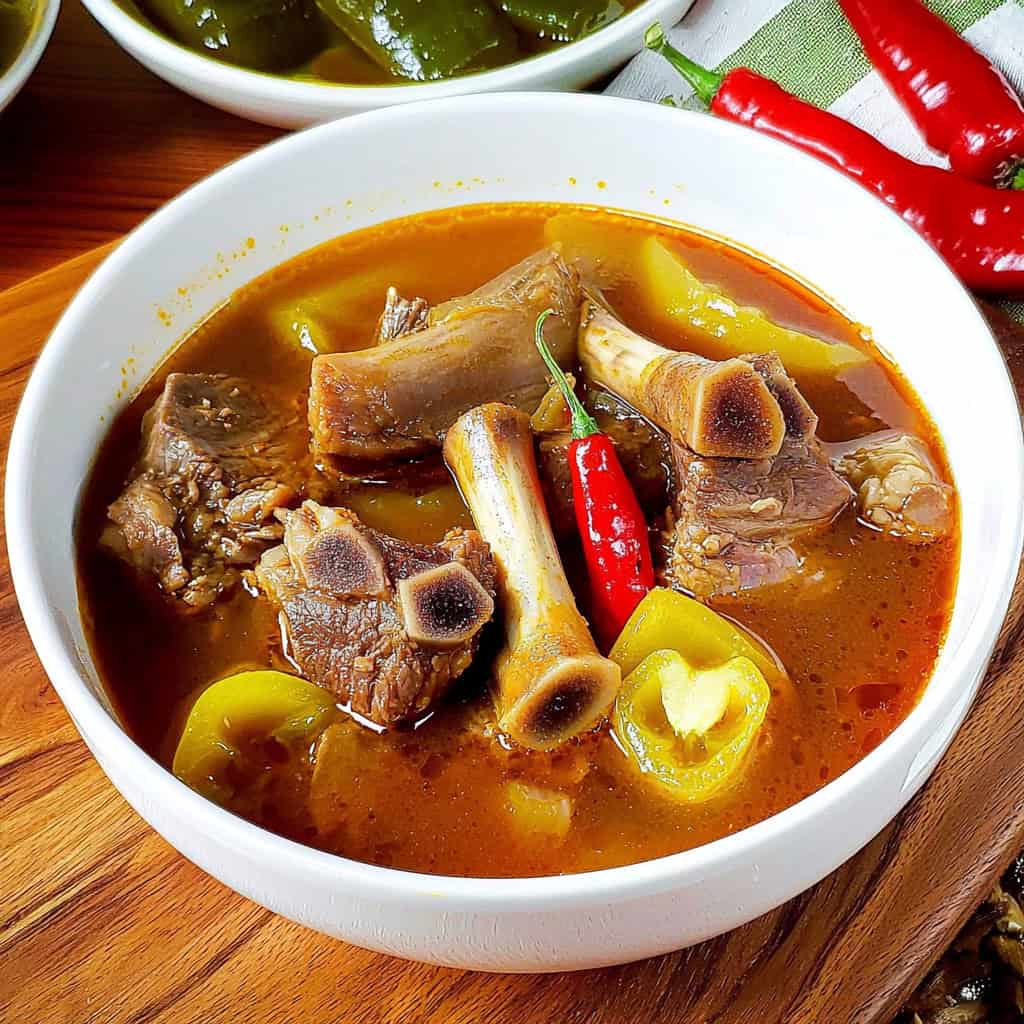I'll never forget my first taste of Kansi in Bacolod, where my ex's Lola served it on a rainy Sunday morning after church. The steam rising from the bowl, the tender beef shanks practically falling off the bone, and that uniquely sour broth – more complex than our usual sinigang back home in Manila – instantly made me understand why locals line up at famous spots for this soup.
The secret, I learned, was in the batwan fruit and that slow-cooked marriage of lemongrass and annatto that gives the broth its distinct reddish hue and depth of flavor. While batwan fruit isn't easily available outside Western Visayas, I've perfected this version using more accessible ingredients that capture that same soul-warming magic I experienced in Bacolod.
Once you try this authentic Ilonggo kansi recipe, it'll become your new rainy day comfort food. It's like sinigang and bulalo had a delicious Ilonggo baby, and I mean that in the best possible way. Perfect for those days when you want to impress your family with something beyond the usual timpla.
What is Kansi?
Kansi is a robust Ilonggo soup featuring beef shanks and young jackfruit in a sour broth infused with lemongrass and annatto. Indigenous to Western Visayas, particularly Iloilo and Bacolod, this rustic dish bridges the heartiness of bulalo with the tangy profile of sinigang, traditionally using batwan fruit for its signature sourness. The result is a complex, nurturing bowl that exemplifies Filipino regional cuisine's mastery of sour-savory flavor combinations.
Jump to:

Why You'll Love This Recipe
- Fork-tender beef that melts in your mouth
- Perfect balance of sour and savory flavors
- Healthier alternative to other beef soups
- One-pot meal that's great for meal prep
- Authentic Ilonggo recipe with modern adaptations
- Loaded with nutritious ingredients
Ingredients
This recipe uses beef shanks for their rich marrow and collagen that creates a deeply flavorful broth when slow-cooked. Lemongrass, garlic, and ginger form the aromatic base that's essential to authentic Filipino soups. For the signature sourness that defines kansi, we use a combination of tamarind powder and kamias as accessible alternatives to the traditional batwan fruit found only in Western Visayas.
Green jackfruit adds hearty texture while absorbing the broth's complex flavors. Annatto powder gives the soup its distinctive reddish color and subtle earthy notes. Thai chilies provide a gentle heat that balances the sourness without overwhelming the dish.
Together, these ingredients create the perfect harmony between the heartiness of bulalo and the tangy profile of sinigang that makes kansi a beloved Ilonggo specialty.

For the Broth Base:
- 2 pounds beef shanks
- 8 cups water
- 2 stalks lemongrass, crushed
- 4 cloves garlic, minced
- 1 thumb-size ginger, minced
- 1 onion, quartered
- 1 tablespoon canola oil
For the Souring Agents and Seasonings:
- 1 package (1.41 ounces) tamarind powder soup base
- 8 pieces kamias (bilimbi)
- 1 tablespoon annatto powder
- 2 Thai chili peppers
- Salt to taste
Main Vegetables:
- 1 can (20 ounces) green jackfruit, drained
Equipment
- Large Heavy-Bottom Pot (Kaldero) - For slow-cooking the beef to tenderness and ensuring even heat distribution
- Sharp Knife - For precisely cutting ingredients and trimming beef shanks
- Wooden Spoon - For gentle stirring without scratching the pot and damaging the surface
- Strainer - For rinsing the beef and removing scum during cooking for a clearer broth
- Measuring Cups and Spoons - For accurate ingredient measurements to maintain flavor balance
- Cutting Board - For safe ingredient preparation and protecting countertops
- Ladle - For serving the hot soup without spills and proper portion control

How To Make
- Begin by rinsing beef shanks thoroughly under cold water and pat dry. Season lightly with salt and pepper at room temperature.
- Heat oil in a large heavy-bottom pot over medium heat. Sear beef shanks until golden brown, about 3-4 minutes per side. Add minced garlic and cook until fragrant, about 30 seconds.
- Pour in water and bring to a boil. Reduce heat to low and skim off any scum that rises to the surface. Add onion, ginger, and lemongrass.
- Cover and simmer on low heat for 1.5-2 hours, maintaining a gentle simmer. Check meat tenderness at 1.5 hours.
- Increase heat to medium-low. Mix annatto powder with ½ cup hot broth and add to pot. Add tamarind powder, jackfruit, kamias, and chilies. Cook for additional 10-15 minutes.
- Season to taste with salt and pepper. Let rest for 5 minutes before serving.

Tips from Lola's Kitchen
- Choose quality beef shanks with a good meat-to-bone ratio for the best flavor and texture
- Don't skip the searing step - it creates a beautiful fond that adds incredible depth to the broth
- Crush lemongrass stalks with the back of your knife to release more essential oils and flavor
- Add kamias gradually to control the sourness level according to your preference
- For a clearer broth, blanch beef shanks in boiling water for 2-3 minutes before starting the recipe
- Simmer, don't boil - keeping the heat low ensures tender meat without toughening the protein
- Let the soup rest before serving to allow flavors to fully develop and meld together
Substitutions
- Batwan (traditional) → Kamias + tamarind powder (as used in this recipe)
- Fresh jackfruit → Canned green jackfruit (drain and rinse well to remove excess brine)
- Lemongrass → 2 teaspoons lemon zest + 1 kaffir lime leaf
- Thai chilies → Bird's eye chilies or jalapeños depending on heat preference
- Fresh tamarind → Tamarind powder or paste (adjust quantity according to sourness)
- Canola oil → Any neutral cooking oil like vegetable or corn oil
- Beef shanks → Beef neck bones or oxtail (adjust cooking time accordingly)
Troubleshooting
- Tough Meat: If beef isn't tender after cooking time, extend simmering by 30-minute intervals until fork-tender
- Too Sour: Add a half cup more water or a pinch of sugar to balance the acidity
- Thin Broth: Simmer uncovered for 15-20 additional minutes to reduce and concentrate flavors
- Oily Surface: Let soup cool slightly and skim excess fat with a large spoon or specialized fat separator
- Bland Taste: Add fish sauce (patis) gradually, a teaspoon at a time, until desired flavor is achieved
- Cloudy Broth: Ensure you're simmering gently and regularly removing scum that rises to the surface
Storage & Reheating
- Refrigerate: Store in airtight containers for up to 3 days. The flavor actually improves overnight!
- Freeze: Portion in freezer-safe containers for up to 3 months. The broth may become slightly cloudy upon thawing but taste remains excellent.
- Reheat on Stovetop: Place in pot over medium heat until internal temperature reaches 165°F, stirring occasionally.
- Microwave Reheating: Heat in 2-3 minute intervals, stirring between each to ensure even heating.
- Add water if needed when reheating as the broth tends to thicken when stored.
- For best results, store broth and beef separately from vegetables if you don't plan to consume immediately.

FAQ
Can I make this in a slow cooker?
Yes, you can! Brown the beef shanks first, then transfer to a slow cooker with all ingredients. Cook on low for 8 hours or high for 4 hours until meat is tender.
Why is my broth cloudy?
A slightly cloudy broth is normal for kansi. For a clearer broth, blanch the meat first by submerging in boiling water for 2-3 minutes, then rinse before proceeding with the recipe. Also, make sure to skim regularly during cooking.
Is this dish spicy?
With just 2 Thai chilies, it's mildly spicy. Adjust the number of chilies according to your heat preference – omit completely for no spice or double for a kick.
Can I use beef chuck instead of beef shanks?
Yes, beef chuck works well as a substitute, though you'll miss out on the rich marrow from the bones. Cut chuck into 2-inch cubes and adjust cooking time (typically 30 minutes less).
How do I know when the meat is done?
The beef should easily fall off the bone when pierced with a fork. If there's resistance, continue cooking until tender.
Can I add other vegetables?
Absolutely! Traditional additions include string beans (sitaw) and bok choy (pechay). Add these in the last 5-7 minutes of cooking.
What makes kansi different from sinigang or bulalo?
Kansi uniquely combines elements of both dishes – the beef and bone marrow richness of bulalo with the sourness of sinigang. The use of jackfruit and annatto oil also gives it a distinct Ilonggo character.
Where can I find kamias or batwan?
Look for kamias in Asian/Filipino markets, often in the freezer section. Batwan is harder to find outside the Philippines, which is why this recipe uses the more accessible kamias-tamarind combination.
Related
Looking for other recipes like this? Try these:

Authentic Ilonggo Kansi (Beef Shank Sour Soup)
Equipment
- Large Heavy-Bottom Pot (Kaldero) For slow-cooking the beef to tenderness
- Sharp Knife (Matatalas na Kutsilyo) For preparing ingredients
- Wooden Spoon (Sandok Kahoy) For gentle stirring without scratching the pot
- Strainer [Salaan] For rinsing the beef and removing scum
- Measuring cups and spoons (Panukat) For precise measurements
- Cutting board (Tabla) For safe ingredient preparation
Ingredients
For the Broth Base:
- 2 pounds beef shanks buto-buto
- 8 cups water tubig
- 2 stalks lemongrass tanglad - crushed
- 4 cloves garlic bawang - minced
- 1 thumb-size ginger luya - minced
- 1 onion sibuyas - quartered
- 1 tablespoon canola oil mantika
For the Souring Agents and Seasonings:
- 1 package 1.41 ounces tamarind powder soup base (sampalok)
- 8 pieces kamias bilimbi
- 1 tablespoon annatto powder atsuete
- 2 Thai chili peppers siling pansigang
- Salt asin at paminta to taste
Main Vegetables:
- 1 can 20 ounces green jackfruit (langka), drained
Instructions
- Begin by rinsing beef shanks thoroughly under cold water and pat dry (Hugasang mabuti ang buto-buto at patuyuin). Season lightly with salt and pepper at room temperature.
- Heat oil in a large heavy-bottom pot over medium heat (200°C/400°F). Sear beef shanks until golden brown, about 3-4 minutes per side (Iprito ang buto-buto hanggang maging golden brown). Add minced garlic and cook until fragrant, about 30 seconds (Igisa ang bawang hanggang mabango).
- Pour in water and bring to a boil. Reduce heat to low (90°C/195°F) and skim off any scum that rises to the surface. Add onion, ginger, and lemongrass.
- Cover and simmer on low heat for 1.5-2 hours (Pakuluan ng mahina ng 1.5-2 oras), maintaining a gentle simmer at 90°C/195°F. Check meat tenderness at 1.5 hours (Suriin ang lambot ng karne pagkalipas ng 1.5 oras).
- Increase heat to medium-low (95°C/200°F). Mix annatto powder with ½ cup hot broth and add to pot (Ihalo ang atsuete sa mainit na sabaw at idagdag sa niluluto). Add tamarind powder, jackfruit, kamias, and chilies. Cook for additional 10-15 minutes (Lutuin ng dagdag 10-15 minuto).
- Season to taste with salt and pepper (Timplahan ng asin at paminta). Let rest for 5 minutes before serving (Palamigin ng 5 minuto bago ihain).
- When reheating, ensure temperature reaches 165°F/74°C (Kapag iinitin, siguraduhing umabot sa 165°F/74°C ang init sa loob).
Tips from Lola's Kitchen
- Look for beef shanks with a good meat-to-bone ratio
- Don't skip the searing step - it adds depth to the broth
- Crush lemongrass to release more flavor
- Add kamias gradually to control sourness
- For clearer broth, blanch beef shanks first
Nutrition
The Story Behind Ilonggo Kansi
Deep in the heart of Iloilo, where the aroma of traditional Filipino cooking wafts through bustling local markets and humble kitchens, Kansi emerged as a testament to Ilonggo culinary ingenuity. This soul-warming soup, often dubbed as the Ilonggo's answer to bulalo, carries a fascinating story that's deeply woven into Western Visayas' food heritage.
Born in the vibrant streets of Bacolod and Iloilo, Kansi (also spelled as Cansi) represents the perfect marriage between two beloved Filipino soup traditions - the richness of bulalo and the sour notes of sinigang. What sets it apart is the use of batwan (Garcinia binucao), a fruit native to Western Visayas that gives the soup its distinctive sourness. This indigenous ingredient has been used by generations of Ilonggo families, marking Kansi as a truly regional masterpiece.
In the busy streets of La Paz Public Market and along the historic Calle Real, local eateries or "cansi houses" have been serving this hearty soup for decades. Notable establishments like Pat-Pat's Kansi in Bacolod have turned this humble dish into a cultural icon, drawing food enthusiasts from across the Philippines. Their version, simmered for hours until the beef shanks become fork-tender, has become the benchmark for authentic Kansi.
Today, this beloved soup has evolved beyond its origins, with each family adding their own touch while maintaining its core elements - tender beef shanks, young jackfruit, and that signature sour broth made vibrant with annatto oil. While batwan might be hard to find outside Western Visayas, home cooks have adapted using more accessible souring agents like kamias and tamarind, ensuring that this Ilonggo treasure can be enjoyed anywhere in the world.
Whether served in fancy restaurants or humble carinderias, Kansi remains a brilliant example of Filipino regional cuisine - resourceful, flavorful, and deeply comforting. It's more than just a soup; it's a bowlful of Ilonggo culture, history, and culinary excellence that continues to captivate palates and warm hearts across generations.










Carla says
Perfect on a rainy day
BennyRhymn says
Can you eat this with rice?
Lars says
tastes better than expected